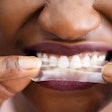
People afflicted with chronic orofacial pain are much more likely to be debilitated by their condition than those with chronic backaches or chronic headaches, according to a study being presented at the 2012 World Congress on Pain in Milan, Italy.
The study was conducted in the departments of oral surgery and oral medicine and facial pain at the Eastman Dental Hospital, University College London. It is part of an ongoing audit of their orofacial pain service.
The data were analyzed by Master of Science student Amin Mokhtari, who was assisted in data collection by four other researchers, including his principal supervisor, Rachel Leeson, BDS, PhD.
“This may create a potential burden on overall healthcare resources.”
— Rachel Leeson, BDS, PhD, Eastman
Dental Hospital
They gave 262 consecutive new patients several pain and psychosocial questionnaires, including the Graded Chronic Pain Scale (GCPS).
Of these, 105 had temporomandibular disorders (TMD), 84 had chronic idiopathic facial pain (CIFP), 63 had neuropathic pain, and 10 had dental pain. The patients' mean age was 49.7 years. The female-to-male ratio was 3:1, and their median duration of pain was 51 months.
The researchers found that the patients with TMD had the highest proportions of grades I and II pain -- which denotes low-disability and low-intensity pain and low-disability and high-intensity pain, respectively -- at 30% and 32%, respectively. Those with CIFP had the highest levels of grades III and IV pain at 23% and 33%, respectively. Grade III pain in the GCPS is high disability-moderately limiting pain, and grade IV is high disability-severely limiting pain.
In total, 50 of the patients (19.1%) had grade III pain on the GCPS, while 79 (30.2%) had grade IV pain, for a total of 129 (49.3%) patients suffering from grade III or IV pain.
The researchers compared these results with those from a chronic headache and chronic back-pain study that also used the GCPS (Journal of General Internal Medicine, May 1998, Vol. 13:5, pp. 296-302). That study found that 19.5% of 662 primary care patients with headaches had grade III pain and 10.5% had grade IV pain.
Of the 1,624 back-pain primary care patients in the study, 20.6% and 15.9% had grades III and IV pain, respectively. The totals of grades III and IV pain for back pain and headache, at 36.4% and 30%, respectively, are significantly lower than the 49.3% for orofacial pain patients in the new study.
The investigators in the current study noted that the profound effects on functioning of chronic orofacial pain may have been previously overlooked and could have significant accompanying economic implications.
"We have plans to study a larger sample of orofacial pain patients in the future as a result of this pilot study," Dr. Leeson said. "In the meantime, these initial results suggest that chronic orofacial pain can have a significant impact on patient's lives, affecting their normal daily activities, ability to work and causing marked disability. This may create a potential burden on overall healthcare resources."



















